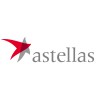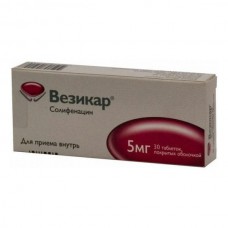Expiration date: 12/2026
The composition and form of issue:
Tablets, film-coated. 1 tablet contains:
solifenacin succinate 5 mg
excipients: lactose monohydrate maize starch hypromellose 3 MPa·magnesium stearate purified water
shell: 03F12967 yellow Opadry (hypromellose 6 MPa·s talc macrogol 8000 titanium dioxide iron oxide yellow)
in a contour acheikova packing 10 PCs in the paper cartons 1, or 3 packaging.
Tablets, film-coated. 1 tablet contains:
solifenacin succinate 10 mg
excipients: lactose monohydrate maize starch hypromellose 3 MPa·magnesium stearate purified water
the shell: Opadry pink 03F14895 (hypromellose 6 MPa·s talc macrogol 8000 titanium dioxide iron oxide red)
in a contour acheikova packing 10 PCs in the paper cartons 1, or 3 packaging.
Description pharmaceutical form:
Tablet 5 mg: round, biconvex, film-coated, light-yellow, marked "150" and the company logo on one side.
Tablet 10 mg: round, biconvex, film-coated, light-pink, marked "151" and the company logo on one side.
Pharmacokinetics:
General characteristics
Absorption. Cmax is achieved after 3-8 h. the Time to reach Cmax is not dose-dependent. Cmax and AUC increased proportionally with increasing doses from 5 to 40 mg Absolute bioavailability is 90%. Eating does not affect the Cmax and AUC of solifenacin.
Distribution. The volume of distribution of solifenacin after in/introductions — 600 L. Solifenacin greatly (about 98%) is associated with plasma proteins, primarily &alpha1-acid glycoprotein.
Metabolism. Solifenacin is actively metabolized by the liver, primarily by cytochrome P450 3A4 (CYP3A4). However, there are alternative metabolic pathway, by means of which can be the metabolism of solifenacin. Systemic Cl of solifenacin is about 9.5 l/h, and the final T1/2 — 45-68 hours After taking the drug inside the plasma in addition to solifenacin were identified the following metabolites: one pharmacologically active (4R-hydroxysulfates) and three inactive (N-glucuronide, N-oxide and 4R-hydroxy-N-oxide of solifenacin).
Excretion. After a single administration of 10 mg 14C-labelled solifenacin after 26 days, about 70% of radioactivity was detected in urine and 23% in the feces. In urine, approximately 11% of the radioactivity detected in the form of unchanged active substance, about 18% — in the form of N-oxide metabolite, 9% — as 4R-hydroxy-N-oxide metabolite and 8% — as 4R-hydroxy metabolite (active metabolite).
The pharmacokinetics of solifenacin are linear in the therapeutic dose range.
Characteristics of pharmacokinetics in individual patients
Age. There is no need to adjust the dose depending on the age of the patients. Studies have shown that exposure of solifenacin (5 and 10 mg), expressed in AUC, was similar in healthy older individuals (65 to 80 years) and healthy young individuals (<55 years). The average rate of absorption, expressed as the mean Tmax was slightly lower, while the final T1/2 is about 20% longer in the elderly. These minor differences are not clinically significant.
The pharmacokinetics of solifenacin have not been determined in children and adolescents.
Paul. The pharmacokinetics of solifenacin are not influenced by the sex of the patient.
Race. Race does not affect the pharmacokinetics of solifenacin.
Renal failure. AUC and Cmax of solifenacin in patients with mild and moderate renal insufficiency did not differ significantly from the corresponding parameters in healthy volunteers. In patients with severe renal insufficiency (Cl creatinine &le30 ml/min) exposition of solifenacin is significantly higher (increase of Cmax is about 30%, AUC >100% and T1/2 more than 60%). There was a statistically significant relationship between creatinine clearance and clearance of solifenacin. Pharmacokinetics in patients undergoing hemodialysis has not been studied.
Liver failure. In patients with moderate liver failure (index Child-Pugh 7 to 9) the value of Cmax does not change, AUC increased by 60%, T1/2 is doubled. Pharmacokinetics in patients with severe hepatic impairment have not been determined.
Description pharmacological action:
Pharmacological studies conducted in vitro and in vivo, have shown that solifenacin is a specific competitive inhibitor of muscarinic receptors, primarily the M3-subtype. It was also found that solifenacin has a low affinity or does not interact with other receptors and ion channels.
The effectiveness of the drug Vesicare in doses of 5 and 10 mg, were studied in several double-blind randomized controlled clinical trials in men and women with the syndrome of overactive bladder, was observed within the first week of treatment and stabilized over the next 12 weeks of treatment. The maximum effect Vesicare may be detected after 4 weeks. Efficiency is maintained over prolonged use (at least 12 months).
Indications:
Urgent (imperative) urinary incontinence, fast and urgent urination (mandatory) the urge to urinate, typical for patients with overactive bladder syndrome.
Contraindications:
- hypersensitivity to the drug
- urinary retention
- severe gastrointestinal disease (including toxic megacolon)
- myasthenia gravis
- angle-closure glaucoma
- a kidney dialysis
- severe liver failure
- severe renal insufficiency or moderate hepatic insufficiency with concomitant treatment of strong CYP3A4 inhibitors such as ketoconazole.
Application of pregnancy and breast-feeding:
No clinical data on women who became pregnant while taking solifenacin. Animal studies have not revealed any direct adverse effects on fertility, development of the embryo/fetus or childbirth. Care should be taken in appointing the drug to pregnant women.
There is no data on the excretion of solifenacin milk in humans. Application Vesicare is not recommended during breastfeeding.
Side effects:
Vesicare can cause side effects associated with anticholinergic solifenacin, often mild or moderate symptoms. The frequency of these undesirable effects depends on the dose. The most frequently noted side effect Vesicare — dry mouth. It was observed in 11% of patients receiving a dose of 5 mg daily, 22% of patients treated with the dose of 10 mg per day, and 4% treated with placebo. The severity of dry mouth was usually weak and only rarely led to interruption of treatment. Overall adherence (compliance) was very high.
The table below shows the other side effects registered in clinical trials Vesicare:
| Side effects | Often (&ge1/100, <1/10) | Infrequently (&ge1/1000,<1/100) | Rarely (&ge1/10000,<1/1000) |
| Violations by the gastrointestinal tract | constipation, nausea, dyspepsia, abdominal pain | gastroesophageal reflux disease, dry throat | colonic obstruction, koprostaz |
| Infections and infestations | urinary tract infection | ||
| Violations from nervous system | drowsiness, dysgeusia (taste disturbance) | ||
| Violations on the part of organs of vision | blurred vision (disturbance of accommodation) | dry eyes | |
| Violation of General condition | fatigue, edema of the lower extremities | ||
| Violations of the respiratory, chest and mediastinum | dryness of the nasal cavity | ||
| Violations of the skin and subcutaneous tissue | dry skin | ||
| Violations of the kidneys and urinary tract | difficulty urinating | urinary retention |
Allergic reactions during clinical trials were noted. However, the possibility of allergic reactions should not be excluded.
Drug interactions:
Pharmacological interaction
Concomitant treatment of drugs with anticholinergic properties may result in more pronounced therapeutic and undesirable effects. After the closure of receipt of solifenacin should be done in about a week break before starting treatment, another anticholinergic drug. The therapeutic effect may be reduced by simultaneous administration of cholinergic receptor agonists. Solifenacin may reduce the effect of drugs that stimulate the motility of the gastrointestinal tract, such as metoclopramide and cisapride.
Pharmacokinetic interaction
In vitro studies have shown that at therapeutic concentrations, solifenacin does not inhibit CYP1A1/2, CYP2C9, ???2?19, CYP2D6 or CYP3A4, isolated from human liver microsomes. It is therefore unlikely that solifenacin will alter the clearance of drugs, metaboliziruemah these CYP-enzymes.
Effect of other drugs on the pharmacokinetics of solifenacin
Solifenacin is metabolized by CYP3A4. Simultaneous administration of ketoconazole (200 mg daily), a strong CYP3A4 inhibitor, caused a twofold increase in AUC of solifenacin, at a dose of 400 mg per day — a threefold increase. So Vesicare the maximum dose should not exceed 5 mg, if the patient is simultaneously taking ketoconazole or therapeutic doses of other strong CYP3A4 inhibitors (such as ritonavir, nelfinavir, Itraconazole). Simultaneous treatment of solifenacin and a strong CYP3A4 inhibitor is contraindicated in patients with severe renal insufficiency or moderate hepatic insufficiency. Since solifenacin is metabolized by CYP3A4, pharmacokinetic interactions are possible with other CYP3A4 substrates with higher affinity (verapamil, diltiazem) and CYP3A4 inducers (rifampicin, phenytoin, carbamazepine).
The effect of solifenacin on the pharmacokinetics of other drugs
Oral contraceptives: revealed no pharmacokinetic interaction of solifenacin and combined oral contraceptives (ethinylestradiol/levonorgestrel).
Warfarin: receiving Vesicare did not cause changes in the pharmacokinetics of R-warfarin or S-warfarin or their effect on PV.
Digoxin: receiving Vesicare had no effect on the pharmacokinetics of digoxin.
Method of application and dose:
Inside, squeezed liquid, irrespective of meal times, of 5 mg 1 time per day. If necessary, the dose may be increased to 10 mg 1 times a day.
Overdose:
The highest dose of solifenacin, which was used by the volunteers was 100 mg in a single dose. At this dose, the most frequently reported side effects are: headache (mild), dry mouth (moderate), dizziness (mild) drowsiness (mild) and blurred vision (moderate). Cases of acute overdose have been reported.
Treatment: use activated charcoal, gastric lavage vomiting do not induce.
As in the case of overdosage of other anticholinergics, symptoms can be treated in the following way:
- severe Central anticholinergic effects (hallucinations, severe anxiety) — physostigmine or carbachol
- if seizures or severe anxiety — benzodiazepines
- respiratory failure — artificial respiration
- tachycardia — beta-adrenoblokatora
- if urinary retention — catheterization
- when mydriasis — instillation in the eye of pilocarpine and/or to darken the room where the patient.
As in the case of an overdose of other anticholinergic drugs, special attention should be given to patients with an established risk of QT interval prolongation (ie, hypokalemia, bradycardia and concomitant administration of drugs that cause QT prolongation) and in patients with heart diseases (myocardial ischemia, arrhythmia, congestive heart failure).
Special instructions:
Before you start treatment with Vesicare, determine if there are other causes of frequent urination (heart failure or kidney disease). If there is a urinary tract infection, it is necessary to start appropriate antibiotic treatment. Vesicare should be used with caution in patients:
- with clinically significant obstruction of the outlet of the bladder, leading to the risk of urinary retention
- c gastrointestinal obstructive disease
the risk of reduced motility of the gastrointestinal tract
- c severe renal (Cl creatinine &le30 ml/min) and moderate hepatic (index Child-Pugh 7 to 9) deficiency dose for these patients should not exceed 5 mg
- at the same time receiving a strong CYP3A4 inhibitor, e.g. ketoconazole
- hernia hiatal, gastroesophageal reflux, and patients concurrently taking drugs (such as bisphosphonates) that can cause or exacerbate esophagitis
- with Autonomous neuropathy.
Patients with rare hereditary disorders of galactose tolerance, lactase deficiency Lapps (Saami), glucose-galaktoznoj malabsorbziei should not take the drug.
Solifenacin, like other anticholinergic drugs, may cause blurred vision and (rarely) drowsiness and feelings of fatigue that could adversely affect the ability to drive and use machines.
Vesicare
(Solifenacin)
- Brand: Astellas



